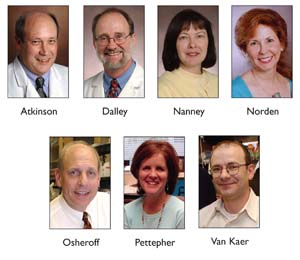
Med School names first Master Science Teachers
As a way of rewarding its most outstanding science educators, Vanderbilt University School of Medicine has named seven faculty members to its first group of Master Science Teachers.
They will collaborate with the 13 Master Clinical Teachers to integrate the basic science and clinical components of the new curriculum.
Named as Master Science Teachers are: Neil Osheroff, Ph.D., professor of Biochemistry; Cathy Pettepher, Ph.D., professor of Cancer Biology; Art Dalley, Ph.D., professor of Cell and Developmental Biology; Luc Van Kaer, Ph.D., professor of Microbiology and Immunology; Lillian Nanney, Ph.D., professor of Plastic Surgery; Jim Atkinson, M.D., Ph.D., professor of Pathology; and Jeanette Norden, Ph.D., professor of Cell and Developmental Biology.
The Master Science Teacher program is designed to enhance medical education and protect time for teaching, as well as to improve the teaching skills of VUSM faculty members, said dean Steven Gabbe, M.D.
“We hope they will serve as role models for other faculty to become better educators. We're trying to broaden our efforts to provide a curriculum of education for our faculty,” Gabbe said.
Department chairs submitted nominations for Master Science Teachers. They are compensated for their participation in the program, which will occupy 5 percent to 20 percent of their time. The Dean's office provides the funding, said Bonnie Miller, M.D., associate dean for Undergraduate Medical Education.
“They have so much pressure to be productive on their grants, that teaching, if it doesn't get funded in some specific way, gets put on the back burner. That's just a reality of an academic medical center. We feel that these are excellent teachers, and funding their teaching effort puts it on the same level as their other responsibilities,” Miller said.
Nanney, director of the Academy for Excellence in Teaching, used the symptom of a cough to outline how the two groups of master teachers will work together.
“When students graduate from VUSM, we expect that at each step along the way, our physicians in training have examined cough from the perspective of gross anatomy, histology, physiology, microbiology, pathology and differential diagnosis in children versus adults,” she said. “All of us have been given the privilege and charge of working synergistically in designing medical learning so that each and every physician emerges after four years with a sophisticated view of the body.”
Dalley said that after 37 years of teaching students about the human body, he remains fascinated with and in awe of it.
“What I enjoy most in my job is facilitating the process of discovery as students gain awareness of the wonders of the structure, function and development of the human body that will be the basis of their study and practice,” he said.
Pettepher said that collaboration among the science and clinical educators is even more critical with the challenge of implementing the new curriculum in all four academic years.
“Students should be provided with a sound knowledge base in the preclinical sciences that they can draw from and apply when trying to reason through clinical scenarios and determining a diagnosis of an illness or disease process in the later years of their academic and professional careers,” she said.
Pathology is one course that directly bridges basic science and clinical medicine. Atkinson has been teaching it at VUMC for the past 22 years.
“Pathology is gratifying and it’s actually fun to see how students react when they realize that what happens at the cellular or organ level is directly responsible for symptoms from diseases, and how those concepts can be used to diagnose and treat those diseases,” he said.
Osheroff, who along with Pettepher and Al George, M.D., co-directs the Molecular Foundations of Medicine course, said the Master Science Teacher designation means a great deal to him.
“The other faculty members who were selected represent some of the finest educators in the School of Medicine. I am honored to be included with these individuals,” he said. “The designation represents the validation of more than 20 years of teaching and directing medical school courses.”
Van Kaer, who directs the Microbiology and Immunology block, said that interacting with students is the most rewarding part of teaching.
“Our students are bright and passionate about becoming physicians.
“The most rewarding part about teaching is when I run into residents and physicians who were my students years ago, and they tell me how much they enjoyed my course,” he said.
Norden, who teaches Medical Neurosciences to second-year medical students, asks them to keep their eyes on their future patients as they acquire a knowledge base about how the brain is organized.
“I also enjoy bringing into the discussion personal issues that involve both the patient and the physician,” she said.
“I want the students to feel empowered and to know that even if a patient cannot be helped medically, or everything that can be done for a patient has been done, that they can still “be there” for the patient in a critical way.
“I want the students to acknowledge and respond to the humanity of their patients, and not to just treat them as manifestations of some disease process.”
Gabbe said he has observed Norden's course and describes her and the other Master Science Teachers as “amazing educators.”
“They have the unique ability to make the basic sciences come alive and put it into a context that is not only more easily learned and remembered, but excites the students about applying it to clinical care,” he said.













